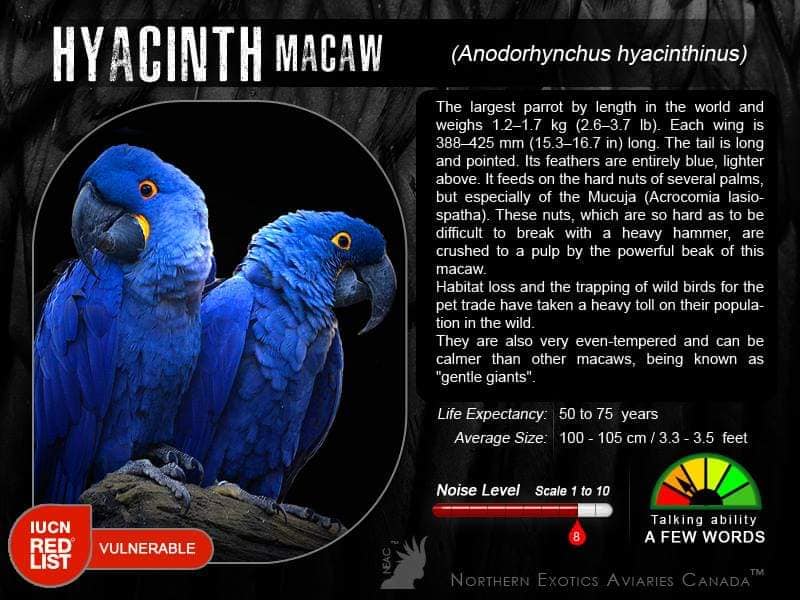Hyacinth Macaw - Anodorhynchus Hyacinthinus - Vulnerable
The hyacinth macaw (Anodorhynchus hyacinthinus), or hyacinthine macaw, is a parrot native to central and eastern South America. With a length (from the top of its head to the tip of its long pointed tail) of about 100 cm (3.3 ft) it is longer than any other species of parrot. It is the largest macaw and the largest flying parrot species, though the flightless kakapo of New Zealand can outweigh it at up to 3.5 kg. While generally easily recognized, it could be confused with the smaller Lear's macaw. Habitat loss and the trapping of wild birds for the pet trade have taken a heavy toll on their population in the wild, so the species is classified as Vulnerable on the International Union for Conservation of Nature's Red List, and it is protected by its listing on Appendix I of the Convention on International Trade in Endangered Species of Wild Fauna and Flora (CITES).
Description
The largest parrot by length in the world, the hyacinth macaw is 100 cm (3.3 ft) long from the tip of its tail to the top of its head and weighs 1.2–1.7 kg (2.6–3.7 lb). Each wing is 388–425 mm (15.3–16.7 in) long. The tail is long and pointed.[3] Its feathers are entirely blue, lighter above. However, the neck feathers can sometimes be slightly grey. The ring around the parrots eyes and area just underneath the beak are a strong, vibrant yellow.
Behaviour
Food and Feeding
The majority of the hyacinth macaw diet is Brazil nuts, from native palms, such as acuri and bocaiuva palms. They have very strong beaks for eating the kernels of hard nuts and seeds. Their strong beaks are even able to crack coconuts, the large brazil nut pods, and macadamia nuts. The birds also boast dry, smooth tongues with a bone inside them that makes them an effective tool for tapping into fruits. The acuri nut is so hard, the parrots cannot feed on it until it has passed through the digestive system of cattle. In addition, they eat fruits and other vegetable matter. The hyacinth macaw generally eats fruits, nuts, nectar, and various kinds of seeds. Also, they travel for the ripest of foods over a vast area.
Tool use
Limited tool use has been observed in both wild and captive hyacinth macaws. Reported sightings of tool use in wild parrots go as far back as 1863. Examples of tool use that have been observed usually involve a chewed leaf or pieces of wood. Macaws often incorporate these items when feeding on harder nuts. Their use allows the nuts the macaws eat to remain in position (prevent slipping) while they gnaw into it. It is not known whether this is learned social behavior or an innate trait, but observation on captive macaws shows that hand-raised macaws exhibit this behavior, as well. Comparisons show that older macaws were able to open seeds more efficiently.
Reproduction
Nesting takes place between July and December, with nests constructed in tree cavities or cliff faces depending on the habitat. In the Pantanal region, 90% of nests are constructed in the manduvi tree (Sterculia apetala). The hyacinth macaw depends on the toucan, for its livelihood. The toucan contributes largely to seed dispersal of the manduvi tree that the macaw needs for reproduction. However, the toucan is responsible for dispersing 83% of the seeds of Sterculia apetala, but also consumes 53% of eggs preyed. Hollows of sufficient size are only found in trees around 60 years of age or older, and competition is fierce. Existing holes are enlarged and then partially filled with wood chips. The clutch size is one or two eggs, although usually only one fledgling survives as the second egg hatches several days after the first, and the smaller fledgling cannot compete with the firstborn for food. A possible explanation for this behavior is what is called the insurance hypothesis. The macaw lays more eggs than can be normally fledged to compensate for earlier eggs that failed to hatch or firstborn chicks that did not survive. The incubation period lasts about a month, and the male tends to his mate whilst she incubates the eggs. The chicks leave the nest, or fledge, around 110 days of age, and remain dependent on their parents until six months of age. hey are mature and begin breeding at seven years of age.
General traits
Hyacinth macaws are the largest psittacine. They are also very even-tempered and can be calmer than other macaws, being known as "gentle giants". An attending veterinarian must be aware of specific nutritional needs and pharmacologic sensitivities when dealing with them. Possibly due to genetic factors or captive rearing limitations, this species can become neurotic/phobic, which is problematic.

Psittaciformes, The Parrot Index, a part of Phoenix Feathers © 2016 - 2023
Page last updated: 12/24/23
Phoenix Feathers

